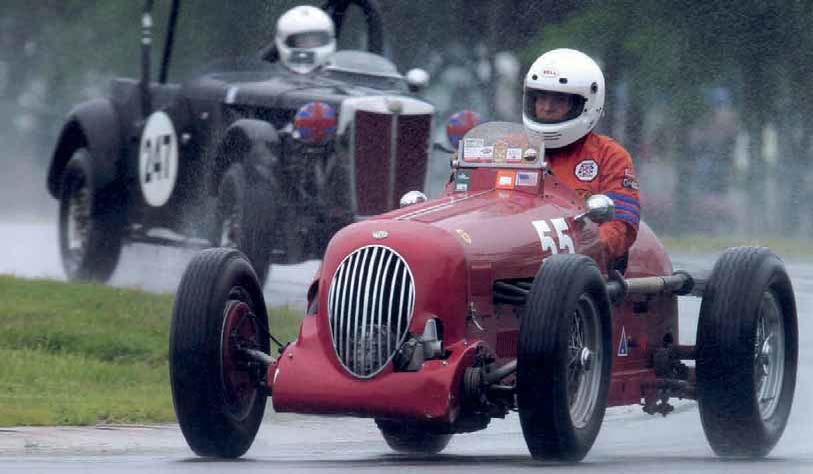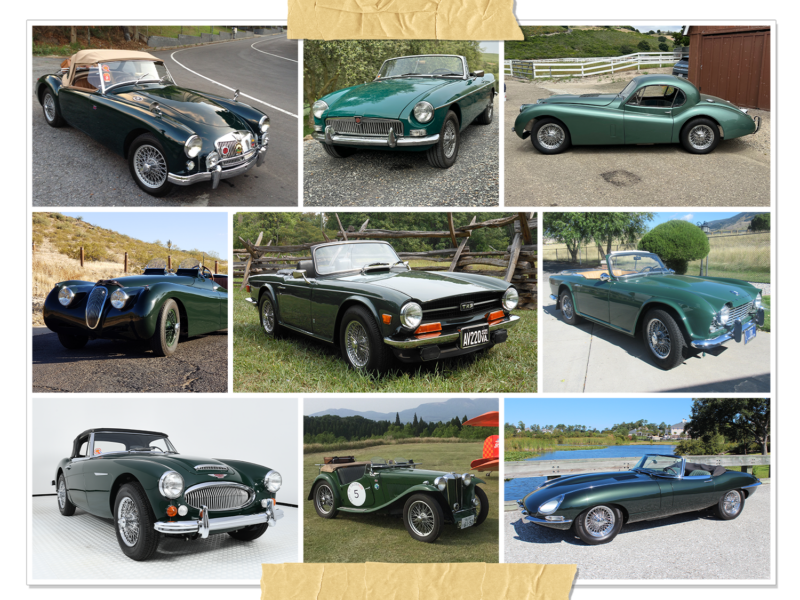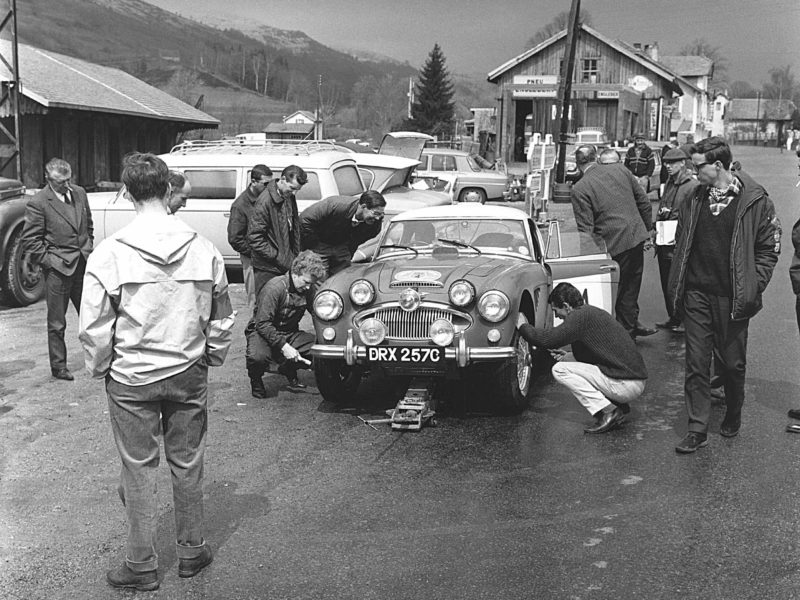By Len Emanuelson
George Chilberg couldn’t help but be a car enthusiast. As he was growing up in Pasadena, California, his grandfather—who owned a Packard dealership—planted the seed. It’s hard to ride around in cars as grand as the Packards of the ’30s without being permanently influenced by them. His father had a profound effect as well. While George’s dad was attending Cal Tech, hot rodding was taking hold of Southern California. He had a souped-up, stripped-down Model T roadster that he street-raced as often as possible. It was this exposure to a wide variety of automotive experiences that would shape George’s enthusiasm for the next 60 years.

The MG 1100cc inline six-cylinder gets fed boost from a front-mounted supercharger. An intake tube travels back to the engine, pressurizing the three-port intake manifold.
In my 30-plus years as an automotive journalist I’ve met a lot of car crazies, but none like George Chilberg. Why? In my opinion, George is the true essence of a car guy. To begin with, he describes his rambling three-acre ranch in Bonsai, California, as a garage with an attached house. At 73 years young, he is chomping at the bit to race his vintage cars any place, any time. Road course, paved speedway, dirt oval, Bonneville, dry lakes, or hill climb—bring it on! Last year he hit the road with his 1934 MG L-Type, racing at Buttonwillow, Laguna Seca, Lime Rock, Watkins Glen, and Del Coronado. Most racers in George’s position would have pulled that one off with a full pit crew in an enclosed semi truck. Instead, he loaded up his trailer and dually by himself, crawled behind the wheel, and struck out for Watkins Glen, arriving 3 ½ days later.

George has owned the ’50 Allard J2 for many years. He vintage raced it for a few years, and has decided to sell it less engine. The car needs a full restoration.
There are many other traits that set George apart from typical collectors and vintage racers. Although he is a British car fan at heart, his collection of vintage cars is very eclectic. Aside from his five ultra-rare British cars, he owns and races a bunch of pre- and post-war Sprint cars, and has a very traditional ’32 Ford roadster hot rod. (More on his collection later.) What determines much of what he owns and drives is his love of rare and exotic engines. He’s a gearhead in the finest sense of the term. There’s a sweet-running Ardun-converted flathead in his J2 Allard, a rare (one of six) Miller Indy engine in one of his pre-war sprinters, and a Cunningham-style Chrysler Hemi lurking in a British hand-built two-seat roadster. Heck, there are engines everywhere you look…he even has three engines on display in his study.
As anyone who has raced knows, maintaining a racecar is a lot of work, especially when dealing with fragile vintage cars. George does his own maintenance—all but the heavy fabrication and engine building. He has a well-equipped workshop with a lathe, mill, and virtually everything else needed to keep his cars running strong. What I really like about George is his attitude towards his cars: they look great, but they are by no means prepped for concours judging. He doesn’t pamper them or worry about dings or imperfections. They are used as they were intended—as everyday road cars and all-out racecars. In fact, it’s not unusual to run across an oil pan punctured by connecting rods that came loose at 6,000 rpm, or Model A transmissions that couldn’t handle the torque of one of his modified Flatheads. He crashed his prized Rex Mays Sprint Car when it back-flipped off the mountain while competing in a hill climb. Because the car was raced before roll bars were required, the sturdy gas tank in the tail was all that kept George from being seriously injured.
George’s affection for British cars began when he purchased a 3-Litre Bentley while stationed in the Air Force in England. His innate ability to “wheel and deal” surfaced when he traded the 3-Litre for an 8-Litre Bentley, then a 4¼ Bentley, and finally a V-12 Lagonda Rapide. He learned early on that to successfully trade in these cars required certain disciplines, like knowing everything there is to know about the vehicles you are interested in—including where they are at all times, who owns them, and how to get in touch with the current owners. George has huge files on individual cars filled with their history and correspondence to current and previous owners. Has this diligence paid off? Well, considering that George has paid literally pennies on the dollar for many of the rare and expensive vehicles in his collection, we’d say it has. Let’s take a look at what he’s got.

George poses with the bulk of his British car collection. Besides the MG Type-L, he has a J2 Allard, Lagonda LG 45 Rapide, and a Bentley Continental R-Type.
The current car that George is most well known for in the vintage racing community is his 1934 MG L-Type K3 recreation. It was built by Len Bull in the ’60s using an L-type frame and N-type axles. The rear uses a standard N live axle, and the brakes are cable-operated mechanical brakes. The car is powered by an MG 1100cc SOHC six-cylinder engine with a front-mounted Volume-Ex supercharger and a huge Solex carb sticking through the grille shell. There were approximately 23 K3s built for racing; all but one were two-seater bodies for sports car racing.
George has driven the wheels off his single-seater and was presented the MGVR Spirit Award two years ago at the annual Focus Event weekend at Virginia International Raceway’s Gold Cup vintage race. More than 70 MGs showed up for the event. The winner of the Spirit Award is selected by a vote of all MG racers at the event. They select the MG driver that best embodies the spirit of MG vintage racing.
Another British car that George raced for a period of time is his 1950 Allard J2. He purchased it out of Auto Trader in the ’80s. It came with the 24-stud Flathead Ford engine that was standard equipment in most J2s. (Many of the 90 J2s built were shipped to the U.S. without engines, and their new owners installed OHV Cadillacs, Nailhead Buicks, and Chrysler Hemis.) Allard fans consider the ultimate powerplant to be a Ford Flathead fitted with an Ardun OHV conversion designed by Zora Duntov. This engine package was light, made excellent power, and the torque didn’t overpower the chassis like the bigger domestic V8s did. So George built an Ardun with four Stromberg carbs and swapped it into the Allard, retaining the three-speed Ford gearbox. The car is in bare aluminum and needs a full restoration, but George is looking to sell the car (less Ardun) because he has too many projects in the works.

Another favorite road car of George’s is this ’37 Lagonda LG45 Rapide, one of only 25 ever built. The side exhaust and boat tail rear lend a Cord-like flavor.
One of the prettiest and most rare cars in George’s collection is his 1937 LG45 Lagonda Rapide. Lagonda was actually founded by American Wilbur Gunn in 1899. He set up a small manufacturing facility in Staines, England, where he produced Lagonda automobiles until it was sold to Aston-Martin in the late ’40s. Lagonda quickly built a reputation as a world-class sports car by winning Le Mans in 1935. George’s LG45 is the last of only 25 built. It is a magnificent open touring car with classic front-end styling and a boat tail rear. George likes driving the open-air Rapide with its torquey 4.5L engine and plans on spending more time driving his road cars and less time racing this year.
George is still a Bentley guy at heart, and his favorite car in the garage is the 1952 Bentley R-Type Continental. He considers it the ultimate collectible Bentley. He loves the fastback lines of the alloy body and the fact that it was the fastest production four-seater built in 1952. Thanks to a slightly hot-rodded Rolls-Royce engine, it would top out around 120 mph faster than the production tires were rated for at the time. After years of looking, George found the R-Type advertised in the L.A. Times. It turned out to be number eight of the 208 R-Type Continentals built between 1952 and 1954. It holds the distinction of being the first left-hand drive model ever built. George has been a member of the Bentley Drivers Club for more than 50 years. The R-Type Continental is certainly a fast and comfortable way to attend club meetings and events.

The Challenger is one of George’s latest projects. It has quite a history. The alloy body was built by Brit Paul Emory and the engine will be an early Chrysler Hemi.
One of the most interesting vehicles George is working on is the Challenger. It is an offshoot of the Challenge, a single-seater road-race car built by Brit Reg Parnell in ’38 or ’39. Parnell built the car to run against the Mercedes and Audis in the lower formula. The Challenge was designed for an engine that was never built, a large-displacement DOHC six-cylinder MG. Instead, it was run with an ERA engine before the war and a roller bearing DeLage engine after the war.
The car was never successful and was purchased by fellow Brit Paul Emory, who installed a V-12 Lagonda engine and gearbox and a two-seater alloy body of his own design. Emory outfitted the car with four large fuel tanks, which leads George to believe that Emory intended to race it at Le Mans. It was unsuccessful as a sports racer too, so it changed hands a number of times. A U.S. Army captain brought it to the States sometime in the ’50s, and it eventually ended up in a salvage yard in Arizona. Someone who saw the car knew that George Chilberg was a Lagonda expert, and put the car and George together. George purchased the car for a small sum of money and put it away for a few years. Finally, he was contacted by Dean Butler from the U.K., who told George that some Brits wanted to restore the Challenge because there were so few British single-seat racecars built in that era. All that Butler wanted was the engine and chassis, so George struck a deal to keep the body and trade the engine and chassis for the MG L-Type he now owns and races. (Pretty shrewd horse-trading.)
So now George is reconstructing a two-seater road car with the Emory-built alloy body that he mounted to a ’49 Ford frame he located that has a fully independent rear suspension. The wheelbase has been stretched to 102 inches, and the frame’s width is nearly a perfect fit for the body. A beautifully turned-out 354cid Chrysler Hemi with multiple era-correct Carter carbs will provide the power, backed up by a modern four-speed transmission. It will certainly be a one-of-a-kind conversation piece with a lot of British car heritage.
Besides the Challenger, George has a vintage Sprint car under construction. George lives with his beautiful wife Janet of 44 years and his faithful Great Dane Lucy. He stays in racing shape by swimming 50 laps in his pool every day. More important, he has the energy and drive of a 40-year-old. Good thing: Maintaining close to 15 cars is no small feat, but it has its rewards. One of George’s proudest moments was receiving the Rolex Cup award at the 2004 Monterey Histories at Laguna Seca.








'George Chilberg: Vintage Racer' has no comments
Be the first to comment this post!